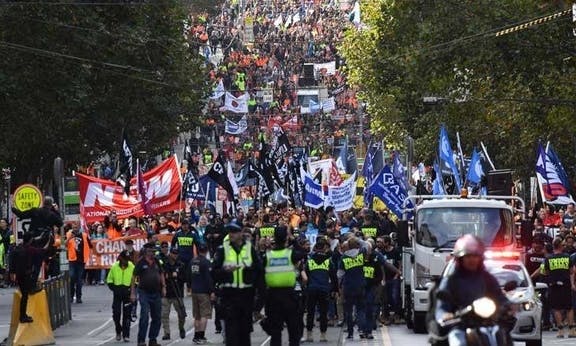Change the Rules: biggest union demonstration in more than a decade

Central Melbourne was shut down today by the largest union demonstration since the campaign against John Howard’s WorkChoices legislation.
Both the Herald Sun and the Age report that up to 100,000 marched in the Change the Rules rally. There were large turnouts from the construction union, the electricians and the National Union of Workers. They were backed up by a solid presence from other unions, including the public sector union, the media union, the shop assistants and the transport unions.
Clearly, when the unions put the work in, they can get a decent turnout. The union movement is far from dead.
Many, many more could have been mobilised if more unions had called on their members to stop work for the day.
The impressive turnout confirms there is widespread concern about stagnant wages, rampant inequality, insecure jobs, the slashing of penalty rates and the lack of decent public services. Workers know that the rules are stacked against them and that the politicians are in the pocket of the big end of town.
Our unions are hemmed in by some of the toughest anti-union laws in the industrialised world and are fined millions of dollars for standing up for the basic rights of their members. Yet the bosses get away with rampant wage theft, sham contracting, unsafe work practices and bank rip offs, with barely a slap on the wrist.
The liveliest part of the march was when we stopped outside the Melbourne Magistrates Court in a show of solidarity with construction union officials John Setka and Shaun Reardon. Setka and Reardon have, outrageously, been charged with the criminal offence of blackmail for proposed industrial action in pursuit of a union claim against building supply firm Boral.
If Setka and Reardon are found guilty it will create a terrible precedent. It will mean that any union member who proposes industrial action in pursuit of improved wages or conditions could be charged with blackmail.
But if the turnout at the demonstration was impressive, the core demands of the Change the Rules campaign were far from clear. The union officials who spoke from the platform were crystal clear on only one thing: the need to get rid of the Turnbull government.
As Susie Allison, the Victorian assistant secretary of the NUW, put it: “We want to put the politicians of the government in insecure jobs. We are going to change the government”.
Fair enough. But that immediately poses a question: what concrete demands are we putting on a Shorten Labor government and how are we going to ensure that it delivers?
We have been through this scenario many times before. The unions mobilise to get Labor elected, while Labor promises next to nothing other than vague waffle about fairness and then delivers even less.
Remember what happened with the massive union mobilisations against WorkChoices, which played a key role in the defeat of the Howard government and even cost Howard his own seat? Labor in opposition promised to tear up WorkChoices, but once in office it made only cosmetic changes.
The vicious anti-union laws we are currently dealing with and the Orwellian-named Fair Work Commission are Labor’s creations.
The unions need to mobilise to demand major positive reforms from Labor, including a substantial increase in the minimum wage, an end to casualisation, genuine equal pay, increased taxes on big business and the rich, more spending on hospitals and key public services, tougher penalties against wage theft and unsafe work practices, the abolition of the anti-union Australian Building and Construction Commission (ABCC) and rolling back the laws restricting union organising and industrial action.
We can’t give Labor a blank cheque. We need to make it clear that the campaign won’t end on election day.